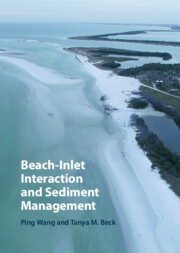Book contents
- Beach–Inlet Interaction and Sediment Management
- Beach–Inlet Interaction and Sediment Management
- Copyright page
- Contents
- 1 Introduction
- 2 Beach and Inlet Systems under Different Geological and Oceanographic Settings
- 3 Hydrodynamics and Sediment Processes Applicable to Beach–Inlet Systems
- 4 Sedimentology and Morphodynamics of Beach–Inlet Systems
- 5 Interaction of Beaches and Inlets
- 6 Methods to Mitigate Beach Erosion and Ensure Inlet Navigation Safety
- 7 Regional Sediment Management at Beach–Inlet Systems
- 8 Resiliency of Beach–Inlet Systems Facing Sea-Level Rise, Storm Impacts, and Human Stresses
- References
- Author Index
- Subject Index
3 - Hydrodynamics and Sediment Processes Applicable to Beach–Inlet Systems
Published online by Cambridge University Press: 15 September 2022
- Beach–Inlet Interaction and Sediment Management
- Beach–Inlet Interaction and Sediment Management
- Copyright page
- Contents
- 1 Introduction
- 2 Beach and Inlet Systems under Different Geological and Oceanographic Settings
- 3 Hydrodynamics and Sediment Processes Applicable to Beach–Inlet Systems
- 4 Sedimentology and Morphodynamics of Beach–Inlet Systems
- 5 Interaction of Beaches and Inlets
- 6 Methods to Mitigate Beach Erosion and Ensure Inlet Navigation Safety
- 7 Regional Sediment Management at Beach–Inlet Systems
- 8 Resiliency of Beach–Inlet Systems Facing Sea-Level Rise, Storm Impacts, and Human Stresses
- References
- Author Index
- Subject Index
Summary
Hydrodynamics and sediment processes at beach–inlet systems are dynamic and complicated. Beach–inlet systems are characteristic of mostly shallow and complicated bathymetry. As ocean waves propagate into shallow water with complex bathymetry, wave refraction, diffraction, shoaling, and breaking occur. The shallow water associated with the ebb tidal delta has significant influence on the pattern of wave propagation. Eventually in the vicinity of the shoreline and over the very shallow portions of the ebb tidal delta, waves break and generate intense turbulence that induce active sediment transport. Both wave and tide play significant roles in transporting sediments and causing morphology change at barrier–inlet systems. In general, wave-induced sediment transport dominates in areas far from the inlet where tidal currents tend to be weak. Within the deeper parts of inlet channels, tide-driven current constitutes the main mechanism for moving sediments. Over the ebb and flood tidal deltas, sediment movements are driven by both wave and current. This chapter reviews the above topics and commonly used equations on the hydrodynamics and sediment transport relevant to the beach–inlet system.
Keywords
- Type
- Chapter
- Information
- Beach-Inlet Interaction and Sediment Management , pp. 39 - 96Publisher: Cambridge University PressPrint publication year: 2022

